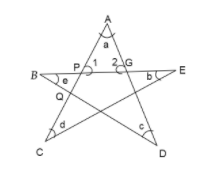
In the star shape shown in figure, the sum of the angle marked at the corners A,B,C,D,E is?

A. 90
B. 135
C. 180
D. 140
E. None of these

Answer
578.7k+ views
Hint: We will solve this question by the sum of triangle. We will solve the question with the help of the angle sum property of a triangle which means the sum of all the angles in the triangle is equal to ${180^ \circ }$.
Complete step-by-step answer:
Let us first take the $\vartriangle PCE$
Angle 1 is exterior angle so, we use the property of exterior angle here
$\angle 1 = \angle b + \angle d$ …………..1
Now, in $\vartriangle BGD$ angle 2 is exterior angle for $\vartriangle BGD$
$\angle 2 = \angle c + \angle e$ ……………2
In $\vartriangle APG$ we know that sum of all the angle of the $\vartriangle APG$ is equal to ${180^ \circ }$
Angles in $\vartriangle APG$ are $\angle a, \angle 1 and \angle 2$
By angle sum property of a triangle
$\angle a + \angle 1 + \angle 2 = {180^{^ \circ }}$
Now, put the value of angle 1 and angle 2 by the equation 1 and 2
$\angle a + \angle d + \angle c + \angle e + \angle b = {180^ \circ }$ \[\]
So, the sum of the all the angles marked at the corners A,B,C,D,E is ${180^ \circ }$
So, the correct answer is “Option C”.
Note: In this question always remember that the angle of each exterior point is always the sum of two adjacent interior angles ${180^ \circ }$.
Alternative method: The adjoining star contains a regular pentagon, and we know the sum of interior angles is $ = {540^ \circ }$, and each angle is of the same measures so we can find the particular angle by dividing the sum by 5.
$ = \dfrac{{540}}{5}$
$ = {108^ \circ }$
It`s supplementary angles measure ${180^ \circ } - {108^ \circ } = {72^ \circ }$
The triangle formed by the star are isosceles triangle in which two angle are $ = {72^ \circ }$
So, we have the find the third angle
=${180^ \circ } - {72^ \circ } - {72^ \circ } = {36^ \circ }$
Each angle at the vertices of the star is equal to ${36^ \circ }$. Thus the sum of all the angle of the star
=${5 \times 36^ \circ } = {180^ \circ }$
Hence the answer is ${180^ \circ }$.
Option C is correct.
Complete step-by-step answer:
Let us first take the $\vartriangle PCE$
Angle 1 is exterior angle so, we use the property of exterior angle here
$\angle 1 = \angle b + \angle d$ …………..1
Now, in $\vartriangle BGD$ angle 2 is exterior angle for $\vartriangle BGD$
$\angle 2 = \angle c + \angle e$ ……………2
In $\vartriangle APG$ we know that sum of all the angle of the $\vartriangle APG$ is equal to ${180^ \circ }$
Angles in $\vartriangle APG$ are $\angle a, \angle 1 and \angle 2$
By angle sum property of a triangle
$\angle a + \angle 1 + \angle 2 = {180^{^ \circ }}$
Now, put the value of angle 1 and angle 2 by the equation 1 and 2
$\angle a + \angle d + \angle c + \angle e + \angle b = {180^ \circ }$ \[\]
So, the sum of the all the angles marked at the corners A,B,C,D,E is ${180^ \circ }$
So, the correct answer is “Option C”.
Note: In this question always remember that the angle of each exterior point is always the sum of two adjacent interior angles ${180^ \circ }$.
Alternative method: The adjoining star contains a regular pentagon, and we know the sum of interior angles is $ = {540^ \circ }$, and each angle is of the same measures so we can find the particular angle by dividing the sum by 5.
$ = \dfrac{{540}}{5}$
$ = {108^ \circ }$
It`s supplementary angles measure ${180^ \circ } - {108^ \circ } = {72^ \circ }$
The triangle formed by the star are isosceles triangle in which two angle are $ = {72^ \circ }$
So, we have the find the third angle
=${180^ \circ } - {72^ \circ } - {72^ \circ } = {36^ \circ }$
Each angle at the vertices of the star is equal to ${36^ \circ }$. Thus the sum of all the angle of the star
=${5 \times 36^ \circ } = {180^ \circ }$
Hence the answer is ${180^ \circ }$.
Option C is correct.
Recently Updated Pages
Why are manures considered better than fertilizers class 11 biology CBSE

Find the coordinates of the midpoint of the line segment class 11 maths CBSE

Distinguish between static friction limiting friction class 11 physics CBSE

The Chairman of the constituent Assembly was A Jawaharlal class 11 social science CBSE

The first National Commission on Labour NCL submitted class 11 social science CBSE

Number of all subshell of n + l 7 is A 4 B 5 C 6 D class 11 chemistry CBSE

Trending doubts
What is meant by exothermic and endothermic reactions class 11 chemistry CBSE

10 examples of friction in our daily life

One Metric ton is equal to kg A 10000 B 1000 C 100 class 11 physics CBSE

1 Quintal is equal to a 110 kg b 10 kg c 100kg d 1000 class 11 physics CBSE

Difference Between Prokaryotic Cells and Eukaryotic Cells

What are Quantum numbers Explain the quantum number class 11 chemistry CBSE




